Text by Peter Hossli Photos by Karl-Heinz Hug
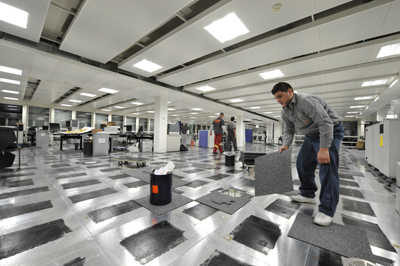
The headline is finished: “Stephanie – The Diet Wonder.” Helbling sends the page to print. It’s the last one for today. “An emotional moment,” he says. “I started out here 21 years ago, and now I’m about to leave this room – and the old-style BLICK.”
A technician removes all wiring from Helbling’s computer. He will erase and reinstall the hard drive overnight. One of the movers takes off table legs, while another collects desk phones. Helbling grabs a plastic container full of lollipops before he goes home, picking his way around moving crates. An orange sticker with a four-digit number identifying its destination is affixed to each crate. They contain the editors’ belongings, and the movers will cart them to their new workstations.
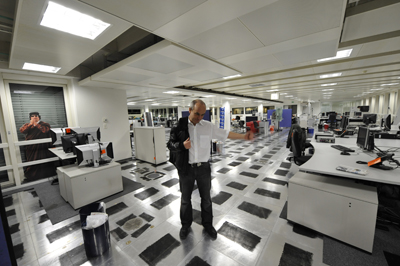
His goal is to prepare Ringier for structural change. Newspaper subscribers are beginning to age. The younger generations rely on digital information. Publishing companies worldwide are finding that people increasingly go online to get their news and use iPhones and Blackberries.
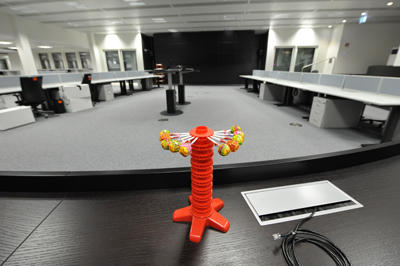
Editorial offices are called newsroom these days. In an integrated newsroom, online and print editors work more closely together. This is complex, but already standard practice. According to Walder, however, the Blick newsroom is “much more complex.” “We are combining print and online, a free-of-charge evening paper, a paid daily newspaper, and a Sunday paper with background information.”
Sunday morning, 8 o’clock. BLICK Editor-in-Chief Ralph Grosse-Bley (50) enters the decision room – where it all happens.
Waiting for him on his new desk are the lollipops that Helbling rescued. He puts the candy on a shelf, throws the plastic container away and boots up his computer.

Ringier’s IT department erased and reinstalled the hard drives of 220 computers overnight. Every machine is now equipped with a new editorial system organized by department, not according to publication as before. In the past, BLICK journalists only had access to BLICK articles. Now everything is available to everybody.
It is now 8:24 a.m. and the video wall begins to flicker, reflecting the media world up to the minute on eighteen 116-cm monitors: oversized displays of websites, television signals, and computer screens. The heads of various desks present ideas for reports, while editors and layout staff keep an eye on the production of today’s paper and photo editors add illustrations. Everybody is able to observe in real time whether a story running on Blick.ch is well received. Correspondents are tuning in via video chat.
At a cost of 275,000 Swiss francs, the video wall is the “heart of the newsroom,” says Christian Glanzmann (48). He is responsible for editorial systems and media production at Ringier, “sort of a funnel for all contents.” The purpose of the video wall is to heighten digital awareness.

The Blick Group now supplies “multiple channels,” Estermann says. A story may start out in BLICK and then run parallel at Blick.ch. “Blick am Abend” will pick it up, and SonntagsBlick provides background information.
The system works because each individual desk is now stronger. Andrea Bleicher, Head of the News desk, assigns stories to 35 journalists and oversees by far the largest news desk in Switzerland. Estermann is convinced that “this strength is a boost to the quality of the reports.”
The newsroom is a fast-paced environment. Meetings will be held standing up. Issues, not publications are key. Ten minutes business news, ten minutes politics, ten minutes lifestyle. In Walder’s opinion “it is more challenging to work in a newsroom, but it is also more exciting.”

Thomas Trüb (57), Member of the Group Executive Board responsible for Asia and New Markets at Ringier, is considered to be the architect of the newsroom. When the publication of “Cash” was discontinued in the summer of 2007 he began to “seriously mull over the idea.” He recruited the former production head of “Cash,” Pascal Zemp (44) as project manager. Zemp’s responsibility was to find the answer to one single question: How do we structure the Blick Group to be compatible in the future?
Accompanied by the editors-in-chief Zemp visited integrated editorial offices in Madrid and London, in Stockholm and Nottingham, in Vienna and Aalberg, Denmark. In June of 2008 SonntagsBlick Editor-in-Chief Marc Walder was named Head of Ringier Switzerland. At that time, Walder, in his own words, was “skeptical” about the idea of a newsroom, but over time his doubt turned into “restrained euphoria.” During the last phase he would visit the construction site at seven in the morning “and get goose bumps seeing so many people trying so hard to build something revolutionary for Switzerland.”
It is now shortly before noon. Rolf Cavalli works on an article about the issues that Swiss voters will decide this weekend. He looks at his watch. The polls will close at noon, and then he will release an initial forecast.
12:22 p.m. “What are you saying?” Grosse-Bley calls out. “What happened to this flight attendant?” “Are you eavesdropping on my conversations with my associates?” Bleicher asks.
An integrated newsroom is transparent. Everybody is aware of what goes on. News travels fast. Nobody can hide anything. “A flight attendant of Swiss was found dead in India.” “Good story, maybe something for the front page. Do we have a picture?” “Not yet.”
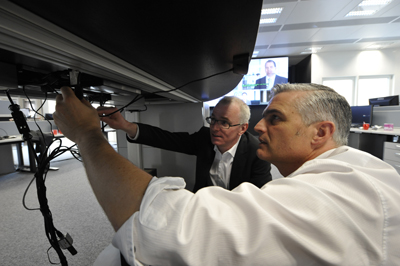
2 p.m. The first stand-up meeting. The flight attendant worked for EasyJet, lived in Geneva and was a French national. “This clearly pushes the story further back.”
Marc Walder stands at the table wearing jeans and a sweater. His comment “you have good stories, considering it’s a Sunday” is motivation for the team.
Ringier’s construction manager, Peter Gasser was supposed to fit 250 workstations into the new space, but it was too small. Gasser (54) reviewed and discarded the idea of housing the editorial office on the ground floor. He also rejected plans to rent space in an existing building or construct a new one. Publisher Michael Ringier ultimately decided to build at Dufourstrasse in the Seefeld neighborhood, home to the Ringier Pressehaus since 1978.
Construction started last July. The structural engineer in charge of Zurich’s Letzigrund stadium gave the go-ahead for a three-story connecting bridge between main building and annex. The bridge has symbolic meaning as a link between old and new, a permanently staffed control center. Trüb, who says he gets all his news from digital sources, defines an integrated newsroom as “[…] journalism without copy deadlines.”
6:30 p.m. Zemp is trying to find telephones for the editors of “Blick am Abend.”
7:17 p.m. Grosse-Bley writes the headline for BLICK: “Federal Council Humiliated, 73 Percent Say No!” That’s it in a nutshell.
11 p.m. BLICK is finished. The first day in the newsroom went by without serious mishaps.
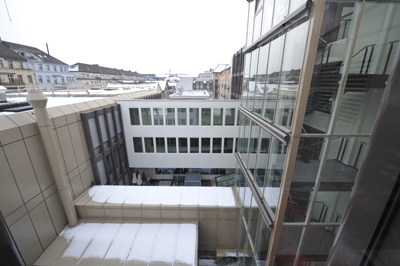
Construction manager Gasser is not completely satisfied. He talks about having to “compromise.” The editorial staff is spread over two floors instead of one, as originally planned. The rooms, primarily off-white and muted gray, have fairly low ceilings. At a height of 3.25 meters and without pillars the decision room is the only one to convey a feeling of space.
This is where the editors-in-chief sit, at a curved desk made of dark wood. Two rows of tables fanning out from the main desk are provided for back-ups, managing editors, and desk managers. The editors work in two adjacent wings, alongside picture researchers and layout personnel.
They are all close together and immediately share new information. A separate lounge is reserved for the editors-in-chief.
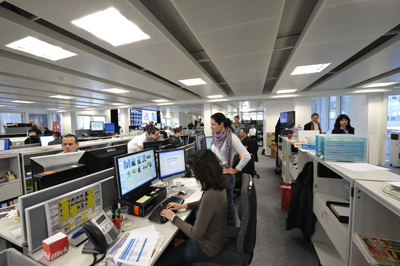
The journalists have height-adjustable tables, rolling stands behind their chairs offering the only file space. They are encouraged to use less paper and increasingly read articles online to promote a digital environment at Ringier.
The company has implemented a “clean desk policy”: At the end of their shift, layout personnel and editorial staff must clear their desks. Reporters are no longer allowed to eat at the computer, and the offices are entirely without greenery. The rooms are climate-controlled, coffee dispensers are equipped with touch screens.
The freed-up space in the Ringier Pressehaus will be used to accommodate other departments, such as “Schweizer Illustrierte,” which will move from Höschgasse to Dufourstrasse this coming fall.

Success will depend on “whether we will be able to achieve real unity among the leadership. The four editors-in-chief have lost their assigned teams and will now have to learn to share staff as well as stories.” “Our reporters are good,” Grosse-Bley adds, “the rest is up to the management.”
Alexander Theobald (45), a consultant and previously a member of the Board of Ringier Switzerland believes he has identified an easily measurable driver for success: “It is enormously important to strengthen the online identity of the Blick brand as a whole.” Integrating the editorial offices will pay off “if user numbers and the quality of online contents increase rapidly and massively.”

Newsroom pioneer Trüb agrees: “Journalists are service providers. In a newsroom they no longer write for a particular publication, they write for an audience and therefore for the market.” And readers increasingly go online. An endless stream of providers is entering the digitalized world. “To be successful in this hailstorm of news, it takes quality, and above all creativity,” Trüb believes and goes on to say that reporters are forced to tell extraordinary stories in a way that grips readers. “To be successful, a story has to achieve a whoa! effect.”
The project will fail “if journalists continue to think within the old structural framework, meaning that they develop products instead of stories.”
Will Ringier be able to retain good journalists and attract the new ones it needs? “If you focus on publishing, you will find a lucrative environment here,” said Estermann. “Stories reach many, many people through many different channels.”
Monday, 6 a.m. Editors begin to trickle in. Zemp fishes the missing telephones out of the trash. They don’t work.
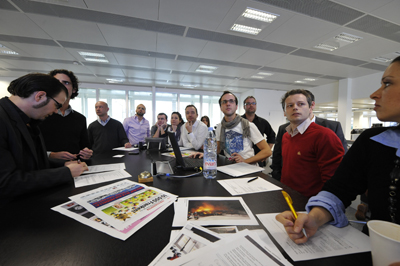
The Human Resources Department guided the journalists through an “in-depth process of change,” explains HR Head Jutta Wurz (40). She prepared the editors-in-chief for a loss of power. While still in charge of a media product, they no longer have their own editorial staff. Desk managers had to give up executive functions. All editors had to be trained in the new work methods.
Ringier hired Theobald as a consultant to bring down the cost. He was given a budget to see “if it can be met,” said Theobald. He added up all editorial pages of text and illustrations that the journalists of the Blick Group produce annually (20,000) and analyzed how much time this takes. Finally he calculated how many employees are necessary to reach the target.
Theobald was met with resentment when he presented the results to the Ringier personnel. They felt it was impossible to measure journalistic work based on industrial standards. “Journalism is creative work and creativity cannot be measured,” Theobald concedes. “My vision is an ideal world.”
10 a.m. Stand-up meeting. Former actress Gwendolyn Rich is the topic of discussion. She currently has a job in sales. “The story is doing great online,” says Cavalli. “Don’t mock her for working in sales” cautions Grosse-Bley, “there are worse jobs.” “Yes,” CEO Walder adds “like working in our newsroom,” earning chuckles all around. His comment has the desired effect. The meeting is brief; topics are suggested at rapid-fire speed.
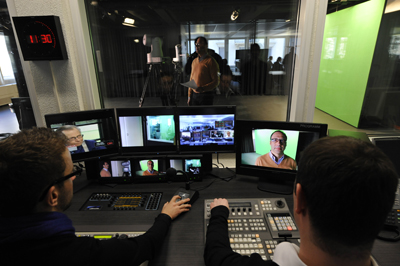
12:45 p.m. A layout specialist arranges the title for “Blick am Abend.” The featured picture shows director James Cameron attempting to throttle Oscar winner Kathryn Bigelow.
The editors-in-chief did not want to let any reporters go or skimp in content. Producers and proofreaders are those who will lose their jobs, those who apply the finishing touches to the articles, who compose titles and captions. Now there are fewer people involved, which “forces journalists to take responsibility,” according to Trüb. Others are wondering if it is possible to play soccer without a goalie.
Downsizing had never been the driver for a newsroom, Trüb says. “Changing a mindset is more dramatic than job cuts.” Ringier will eliminate 22 full-time positions. Twenty-five employees were let go. Three will take non-voluntary early retirement. They will receive a severance package with full pay for up to one year in special hardship cases. “We have improved the severance program because we know how difficult the job market is for journalists at this point,” said HR Head Wurz.

Political editor Joël Widmer decided not to move. He will join “SonntagsZeitung.” “The newsroom made it easier for me to accept an offer from the competition,” he says. Some Ringier editors fear that the job cuts will drive down quality. Fewer people do not necessarily make better journalism. Walder disagrees: “Every desk manager now has a much larger department available,” he insists. “Instead of small cells in four editorial offices, all we have now is large cells.” Also, quality depends not only on the size of the editorial staff: “I prefer to have good people rather than many people.”
Grosse-Bley agrees that the music is not better if you add five musicians to an orchestra, “however, with three people you can offer chamber music at best, but not a symphony.”
Tuesday 10:02 a.m. “It’s already past ten again,” Grosse-Bley notes. Eighteen people are assembled around the table. The meeting progresses swiftly: three minutes for sports, six for news, eight for business news, ten for people news, and seven for politics. On the video wall, image editors have already displayed the photos that will accompany the stories.
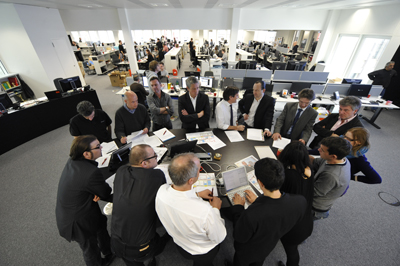
For the former journalists of SonntagsBlick this is a major change. They are used to having more time, writing more in-depth stories. Now you might find them hanging out in the hallways, wondering about the future. “Can they force us to write for BLICK?” one editor asks. “Who do I offer my stories to?” “If we deliver the input, the story will end up in SonntagsBlick,” another ventures.
“Exercising their elbows,” is what the people at SonntagsBlick will have to do, one maintains, “otherwise BLICK will become too domineering and steamroll SonntagsBlick.” But – there are no more SonntagsBlick editors. A few reporters will form a “SoBli” core team, but only for the first three months. After that, all associations will be cut.
10:30 a.m. “Anything else?” Grosse-Bley asks. The group is silent. “Okay we’re done.”

External consultants had advised him to start out with one editor-in-chief. He chose not to follow their recommendation. “We have good leaders,” he believes. “They will preserve the identity of each publication.” A superman who can do it all, who understands and represents online as well as print “does not yet exist.” It’s a matter of time, Trüb predicts. “Someone has to be at the helm of the integrated newsroom.” If it were up to him alone, “we would have started out with one editor-in-chief.”
The objective of the newsroom is to position Ringier as the most innovative publishing company in Switzerland. “Compared to the others, we are mentally a big step ahead,” says IT manager Glanzmann. “No other publishing company has such a well-honed understanding of the new media.”
In Walder’s opinion, this is the publisher’s accomplishment. “Any time he speaks, Michael Ringer virtually provokes innovation.” And he adds: “Obviously, the crisis has forced us to be innovative.”
A 15-percent annual return on equity is his goal for Ringier Switzerland. Not an easy feat. Walder disagrees and explains that some Ringier units already achieve greater returns, Betty Bossi, for example, or Geschenkidee.ch. “Profitability is important,” Walder comments, “not to allow Mr. Ringier to add to his art collection, but to generate money for new products,” primarily journalistic products. While Ringier concentrated on entertainment and e-commerce during the last twelve months, “the focus is now clearly on our core business again, newspapers and magazines,” he said. “Job cuts in the editorial offices are currently not conceivable.” Walder announces the opposite: “We will grow again as a result of the newsroom.” An objective that publisher Ringier emphasized recently during a meeting of the Ringier editors-in-chief is that “we will soon have more people working in the newsroom than we are starting out with now.”
Their job is to develop magazines, applications for iPhone and Blackberry, and for the Apple iPad, which will be available soon, for electronic reading devices. “Ringier will start charging for digital contents in the future,” Trüb said. He feels that this is necessary. If the company had not responded and continued to follow the old patterns in the editorial offices, “we would have died of beauty.”

Grosse-Bley shares his views. “We now have state-of-the-art equipment, but it takes people to make good journalism,” says the Head of BLICK. “It is not the computers that write thrilling stories. This is what outstanding writers do, and then they obviously make good money. Quality, he adds “costs money, to put it simply.”
Will the integrated newsroom be commercially profitable? The verdict is still out. “Ultimately, it was a business decision to accept this risk now,” says Trüb. “But it would be far more risky not to try.”
Tuesday night, shortly before midnight in the editorial office of the Blick Group. The day is coming to a close, a new one about to dawn. News never stops. Journalists are arriving for work. People are waiting for stories.

French philosopher Paul Virlio writes a lot about this subject. He has a new book out called The Aesthetics of Disappearance.
http://csmt.uchicago.edu/annotations/virilioaesthetics.htm